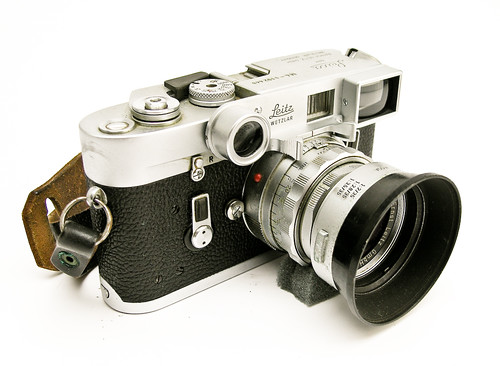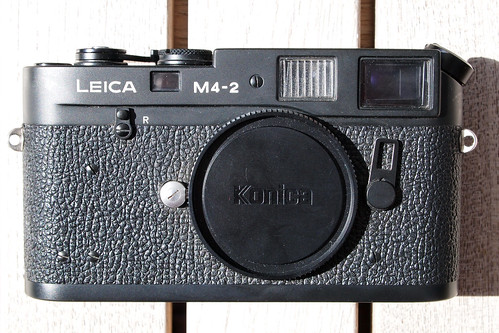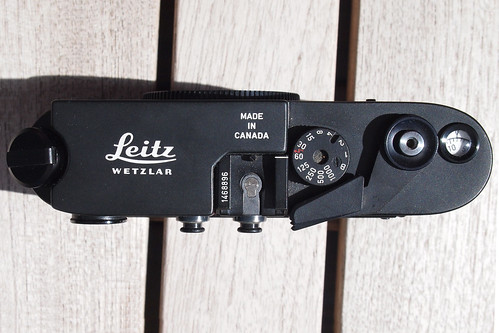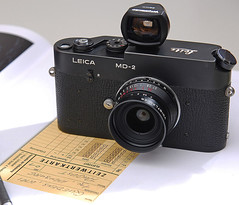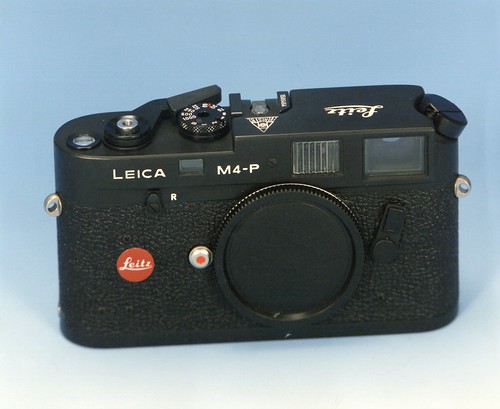Difference between revisions of "Leica M4"
m (Added more informative image text) |
Hanskerensky (talk | contribs) (Added link to user manual page) |
||
| (28 intermediate revisions by 9 users not shown) | |||
| Line 1: | Line 1: | ||
| − | {| | + | {{Infobox_35mm_RF_system|camera name='''Leica M4''' |
| − | | | + | |image source=http://www.flickr.com/photos/chrizzle/2445039228/in/pool-camerawiki |
| + | |image=http://farm3.static.flickr.com/2380/2445039228_e90544aae1.jpg | ||
| + | |image caption=M4 with 50mm and viewfinder 'spectacles'<br/>Image by {{image_author|Christopher Robin Roberts}} {{creative commons}} | ||
| + | |maker=[[Leica]] | ||
| + | |dates=M4 1967-1972, M4-2 1977-1983, M4-P 1980-1985 | ||
| + | |variants=M4 silver-black, M4-2/M4-P black | ||
| + | |viewfinder=Reverse Galilean (magnification ×0.72) | ||
| + | <br/>with automatic or manual selection of [[parallax|parallax corrected]] framelines | ||
| + | |rangefinder=[[coupled rangefinder|coupled]], combined ([[rangefinder base|ERB]] = 47.1mm) | ||
| + | |lens mount=Leica M | ||
| + | |shutter type=[[focal plane shutter|focal plane]]<br>cloth curtains, horizontal travel | ||
| + | |min shutter speed=1/1000 | ||
| + | |max shutter speed=1s | ||
| + | |exposure meter=None | ||
| + | |exposure modes=manual | ||
| + | |iso range=160 to 2500 [[ASA|ISO]] | ||
| + | |shoe=fixed (hotshoe from M4-2) | ||
| + | |sync=X | ||
| + | |sync speed=1/50 | ||
| + | |ttl flash=No | ||
| + | |motor drive=No (motor winder from M4-2) | ||
| + | |battery=None | ||
| + | |dimensions=138×77×38mm | ||
| + | |weight=550g | ||
| + | |number produced=unknown | ||
| + | }} | ||
| + | |||
| + | The '''Leica M4''' was introduced in 1967, replacing the 1954 [[Leica M3]] with a number of improvements; particularly much improved film handling and viewfinder bright lines for wide angle lenses. | ||
| + | |||
| + | Like the [[Leica M3|M3]], the M4 is an all mechanical manual exposure rangefinder camera without a built in exposure meter. | ||
| + | |||
| + | The M4 was Leica's last camera produced largely with hand assembly. | ||
| + | |||
| + | ===Film handling=== | ||
| + | Loading and rewinding film was made much easier. A redesigned take up spool simplified film loading, and a crank in place of the earlier knob made rewinding easier and faster. | ||
| + | |||
| + | {{Flickr_image | ||
| + | |image_source= http://www.flickr.com/photos/90900361@N08/10434670146/in/pool-camerawiki | ||
| + | |image= http://farm3.staticflickr.com/2837/10434670146_ed5996f6b7.jpg | ||
| + | |image_align= left | ||
| + | |image_text= 1969 M4 with 50mm f/2.8 Elmar | ||
| + | |image_by= Geoff Harrisson | ||
| + | |image_rights= wp | ||
| + | }} | ||
| + | |||
| + | {{br}} | ||
| + | |||
| + | ==M4-2== | ||
| + | {|class=floatright | ||
| + | | | ||
| + | {{Flickr_image | ||
| + | |image_source= http://www.flickr.com/photos/pekdeche/5005750413/in/pool-camerawiki | ||
| + | |image= http://farm5.static.flickr.com/4091/5005750413_920b0b2484.jpg | ||
| + | |image_align= | ||
| + | |image_text= | ||
| + | |image_by= Pekdeche | ||
| + | |image_rights= wp | ||
| + | }} | ||
|- | |- | ||
| − | || | + | | |
| + | {{Flickr_image | ||
| + | |image_source= http://www.flickr.com/photos/pekdeche/5005749333/in/pool-camerawiki | ||
| + | |image= http://farm5.static.flickr.com/4074/5005749333_130860caaf.jpg | ||
| + | |image_align= | ||
| + | |image_text= | ||
| + | |image_by= Pekdeche | ||
| + | |image_rights= wp | ||
| + | }} | ||
| + | |} | ||
| + | Following the disastrous [[Leica M5|M5]], the M4 was reintroduced in 1978 as the M4-2 manufactured in Canada, with only detail differences. Manufacture was simplified and largely mechanised, reducing the very high cost of earlier production. | ||
| + | |||
| + | For the first time provision was made from the outset for a motor winder which would also fit the M4-P and [[Leica M6|M6]] (but not the earlier [[Leica M5|M5]]). Although smaller than the earlier M2 winder, the Winder M4-2 was still substantial and more than half the size of the camera body. | ||
| + | {{br}} | ||
| + | |||
| + | ==MD-2== | ||
| + | {|class=floatright | ||
| + | | | ||
| + | {{Flickr_image | ||
| + | |image_source= http://www.flickr.com/photos/49243657@N07/4604362000/in/pool-camerawiki | ||
| + | |image= http://farm4.static.flickr.com/3357/4604362000_1cea82d327_m.jpg | ||
| + | |image_align= right | ||
| + | |image_text=MD-2 with [[Cosina Voigtländer]] wide-angle lens mounted | ||
| + | |image_by= boredom™ | ||
| + | |image_rights= wp | ||
| + | }} | ||
| + | |} | ||
| + | Like the earlier MD variant of the [[Leica M3|M3]], the MD-2 was a version of the M4-2 without a viewfinder intended primarily for scientific use on a microscope or telescope. | ||
| + | {{br}} | ||
| + | |||
| + | ==M4-P== | ||
| + | {|class=floatright | ||
| + | | | ||
| + | {{Flickr_image | ||
| + | |image_source= http://www.flickr.com/photos/tango-/6963574569/in/pool-camerawiki/ | ||
| + | |image= http://farm8.staticflickr.com/7196/6963574569_09283b21c3.jpg | ||
| + | |image_align= right | ||
| + | |image_text= black M4-P | ||
| + | |image_by= Tiberio Frascari | ||
| + | |image_rights= with permission | ||
| + | }} | ||
|} | |} | ||
| − | The | + | |
| + | Built from 1980 to 1986, with serial numbers from 1543351 to 1692950, successor to the M4-2 and likewise made in Canada. The main difference is six viewfinder frames for 28/35/50/75/90/135 lenses by displaying the following combinations: 35/135mm, 50/75mm, and 28/90mm. 28mm and 75mm frames were added for newer lenses. The M4-P also has the .72 magnification viewfinder found in the [[Leica M6|M6]] and available for the [[Leica M7|M7]]. | ||
| + | |||
| + | Most M4-Ps were finished in black chrome, while some silver-chrome units were also available. [[Leica M6|M6]] started production in 1984, overlapping production of the M4-P, and later M4-Ps shared the same rangefinder as the M6. | ||
| + | {{br}} | ||
| + | |||
| + | ==Links== | ||
| + | *[http://www.butkus.org/chinon/leica/leica_m4/leica_m4.htm Leica M4 user manual] at [https://www.butkus.org/chinon/ Butkus.org] | ||
| + | *[https://www.butkus.org/chinon/leica/leica_m4-2/leica_m4-2.htm Leica M4-2 user manual] at [https://www.butkus.org/chinon/ Butkus.org] | ||
| + | *[https://www.butkus.org/chinon/leica/leica_m4-p/leica_m4-p.htm Leica M4-P user manual] at [https://www.butkus.org/chinon/ Butkus.org] | ||
| + | *[http://www.collection-appareils.fr/x/html/page_standard.php?id_appareil=11436 Leica M4-2] at [http://www.collection-appareils.fr/general/html/francais.php Sylvain Halgand's www.collection-appareils.fr] (in French) | ||
| + | *[http://www.cameraquest.com/mguide.htm#M4-2%20and%20M4-P Leica M-series guide] at Stephen Gandy's [http://www.cameraquest.com/classics.htm CameraQuest] | ||
| + | * [http://www.luistriguez.es/fotos/cameras/leica_m4_2/index-leicam4_2.htm Leica M4-2] by luis triguez | ||
| + | |||
| + | [[Category:German 35mm rangefinder]] | ||
| + | [[Category:Leica]] | ||
| + | [[Category: Leica M mount]] | ||
| + | [[Category:L]] | ||
| + | |||
| + | <!-- Irrelevant content commented out | ||
| + | The reason is the finder optics and the superior mechanical quality, not convincingly equalled in later models. However, the question of which is best, boils down to preferences with regards to the finder magnification and which finder frames are needed. Otherwise, there is actually not very much difference among the classic Leica M's, other than the early Leica M3 with double stroke wind lever, the rangefinder-less M1, and the slanted Leica M4 rewind knob. | ||
The Leica has a particular shutter sound that connoisseurs appreciate, and there is the highly appreciated feel of quality in every detail. Never the less, the modern Leicas are far removed from the original handmade screw lensmount cameras built of an aluminium tube, steel spindles, and brass plates screwed together. The M-body is a metal casting machined to close tolerances, and every component made to perform reliably under strenuous conditions. The four-pronged lensmount is quick and reliable, and the relevant parallax compensated field-of-view frame is automatically shown in the finder. The standard lens for the M4 would be any number of top quality Leica Lenses. | The Leica has a particular shutter sound that connoisseurs appreciate, and there is the highly appreciated feel of quality in every detail. Never the less, the modern Leicas are far removed from the original handmade screw lensmount cameras built of an aluminium tube, steel spindles, and brass plates screwed together. The M-body is a metal casting machined to close tolerances, and every component made to perform reliably under strenuous conditions. The four-pronged lensmount is quick and reliable, and the relevant parallax compensated field-of-view frame is automatically shown in the finder. The standard lens for the M4 would be any number of top quality Leica Lenses. | ||
| − | [[Leitz]] in Wetzlar was long convinced that their camera concept was perfect and could be made to suit any | + | [[Leitz]] in Wetzlar was long convinced that their camera concept was perfect and could be made to suit any conceivable task within reason only by providing specialized accessories. In the beginning, this worked fine and any institution with a minimum of self-respect would acquire a Leica outfit for documentation work or for their microscope. The camera finder was not suitable for telephoto focusing and framing, so a reflex housing was devised for long lenses and close-up work, using the SLR principle. It is a truly adaptable system. |
This being the case, it took Leitz particularly long time to realize that the SLR camera actually could make some sense after all. The Leicaflex was introduced in 1965, and was a beautiful, outdated camera from early on, but eventually the Leica range of SLR cameras caught on, and they are still an item to consider some forty years later; but the remarkable fact is that so are the Leica M cameras! | This being the case, it took Leitz particularly long time to realize that the SLR camera actually could make some sense after all. The Leicaflex was introduced in 1965, and was a beautiful, outdated camera from early on, but eventually the Leica range of SLR cameras caught on, and they are still an item to consider some forty years later; but the remarkable fact is that so are the Leica M cameras! | ||
| Line 18: | Line 135: | ||
In addition, there have been several shorter runs of models, like the MP professional and the MD with no finder. Se [[Leica M chronology]] list. | In addition, there have been several shorter runs of models, like the MP professional and the MD with no finder. Se [[Leica M chronology]] list. | ||
| − | [[Category:Leica]] | + | |
| + | --> | ||
| + | [[Category:Leica|M4]] | ||
| + | [[Category: Leica M mount]] | ||
| + | [[Category:M|M4 Leica]] | ||
| + | [[Category:German 35mm rangefinder]] | ||
Latest revision as of 07:33, 19 March 2022
| Leica M4 |
|---|
|
Maker: Leica Dates: M4 1967-1972, M4-2 1977-1983, M4-P 1980-1985 Variants: M4 silver-black, M4-2/M4-P black Camera Type: 35mm rangefinder system Focusing: manual Viewfinder: Reverse Galilean (magnification ×0.72)
Rangefinder: coupled, combined (ERB = 47.1mm) Lens mount: Leica M Shutter: focal plane Exposure meter: None Exposure modes: manual ASA/ISO range: 160 to 2500 ISO Shoe: fixed (hotshoe from M4-2) Synchronized: X X sync speed: 1/50 TTL Flash: No Motor drive: No (motor winder from M4-2) Battery: None Dimensions: 138×77×38mm Weight: 550g Number produced: unknown |
The Leica M4 was introduced in 1967, replacing the 1954 Leica M3 with a number of improvements; particularly much improved film handling and viewfinder bright lines for wide angle lenses.
Like the M3, the M4 is an all mechanical manual exposure rangefinder camera without a built in exposure meter.
The M4 was Leica's last camera produced largely with hand assembly.
Contents
Film handling
Loading and rewinding film was made much easier. A redesigned take up spool simplified film loading, and a crank in place of the earlier knob made rewinding easier and faster.
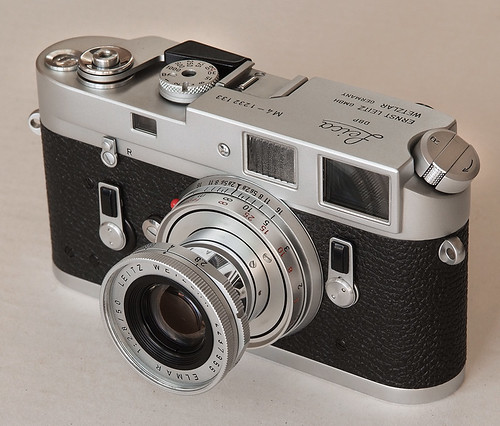
|
| 1969 M4 with 50mm f/2.8 Elmar image by Geoff Harrisson (Image rights) |
M4-2
| ||
|
Following the disastrous M5, the M4 was reintroduced in 1978 as the M4-2 manufactured in Canada, with only detail differences. Manufacture was simplified and largely mechanised, reducing the very high cost of earlier production.
For the first time provision was made from the outset for a motor winder which would also fit the M4-P and M6 (but not the earlier M5). Although smaller than the earlier M2 winder, the Winder M4-2 was still substantial and more than half the size of the camera body.
MD-2
|
Like the earlier MD variant of the M3, the MD-2 was a version of the M4-2 without a viewfinder intended primarily for scientific use on a microscope or telescope.
M4-P
|
Built from 1980 to 1986, with serial numbers from 1543351 to 1692950, successor to the M4-2 and likewise made in Canada. The main difference is six viewfinder frames for 28/35/50/75/90/135 lenses by displaying the following combinations: 35/135mm, 50/75mm, and 28/90mm. 28mm and 75mm frames were added for newer lenses. The M4-P also has the .72 magnification viewfinder found in the M6 and available for the M7.
Most M4-Ps were finished in black chrome, while some silver-chrome units were also available. M6 started production in 1984, overlapping production of the M4-P, and later M4-Ps shared the same rangefinder as the M6.
Links
- Leica M4 user manual at Butkus.org
- Leica M4-2 user manual at Butkus.org
- Leica M4-P user manual at Butkus.org
- Leica M4-2 at Sylvain Halgand's www.collection-appareils.fr (in French)
- Leica M-series guide at Stephen Gandy's CameraQuest
- Leica M4-2 by luis triguez
